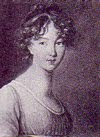 One of the biggest challenges in recreation of objects from the past is colour. Textiles from the past can be faded or have dyes which have unrecognisably changed. Paintings in good condition, and preferably seen in person, are an excellent source although the skeptic in me sometimes wonders about artistic license. Fabric companies in the United States, Britain and the Netherlands have, however, provided me with another source over the last ten years or so by reproducing lines based on quilts or other objects in excellent condition from the collections of major museums, supported by reliable research. I have made many reproduction quilts from the late 18th century through the 19th century using these lines, some of which are featured in the photograph which, unfortunately, appears here as a little cloudy or faded; the fabrics are much more vibrant in person. Of course, simply because a fabric was dyed with a specific blue or red does not always mean that one could have found wool, silk, cotton or linen in that shade but research about fabric, clothing, household and decorative arts objects, and the dyeing techniques (including longevity) related to them are always a good place to begin when I am planning a new project.
One of the biggest challenges in recreation of objects from the past is colour. Textiles from the past can be faded or have dyes which have unrecognisably changed. Paintings in good condition, and preferably seen in person, are an excellent source although the skeptic in me sometimes wonders about artistic license. Fabric companies in the United States, Britain and the Netherlands have, however, provided me with another source over the last ten years or so by reproducing lines based on quilts or other objects in excellent condition from the collections of major museums, supported by reliable research. I have made many reproduction quilts from the late 18th century through the 19th century using these lines, some of which are featured in the photograph which, unfortunately, appears here as a little cloudy or faded; the fabrics are much more vibrant in person. Of course, simply because a fabric was dyed with a specific blue or red does not always mean that one could have found wool, silk, cotton or linen in that shade but research about fabric, clothing, household and decorative arts objects, and the dyeing techniques (including longevity) related to them are always a good place to begin when I am planning a new project.
Sold at Auction- Regency Era Dresses
2 days ago



